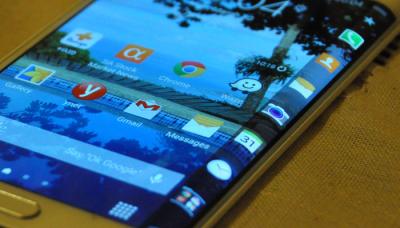Super AMOLED: introduction and market status
OLED displays use organic materials that emit light when electricity is applied. OLEDs enable emissive, bright, thin, flexible and efficient displays. OLEDs are replacing LCDs in most display applications - from smartphones and wearables to monitors and TVs.

Samsung's Super AMOLED displays, announced in 2010, are AMOLED displays for mobile devices (such as smartphones, wearables and tablets) with an integrated touch function. The thickness of the touch sensor is just 0.001 mm and this allows the screen to provide better images and to have great visibility even in direct sunlight compared with regular AMOLED displays with an external touch layer.
Samsung is producing hundreds of millions of Super AMOLED displays today, used mostly in smartphones, but also in other devices. These are considered to be some of the best displays on the market.
Super AMOLED and the Pentile matrix
Samsung's Super AMOLED displays use a Pentile matrix sub-pixel design. That means that the green sub-pixel is shared by two pixels and the display has only 2 sub-pixels per real 'pixel' compared to the classic RGB matrix design (or Real-Stripe). You can see a PenTile matrix vs a Real-Stripe one on the images below (the PenTile is on the right). Newer Super AMOLED displays use a different PenTile matrix (Diamond Pixel pattern).
Super AMOLED vs Dynamic AMOLED
In 2019 Samsung introduced its next-generation mobile display technology, which it calls Dynamic AMOLED. Basically a Dynamic AMOLED is similar to a Super AMOLED display, but it adds HDR support. Samsung's highest end smartphones adopt the company's Dynamic AMOLED 2X LTPO AMOLED displays.
Further reading
- Introduction to OLEDs
- Samsung's OLED displays
- Pentile Technology explained
- Flexible OLEDs
- OLED mobile phones
- The OLED Toolbox: a one-stop-shop for OLED information, insights, analysis and guides
T-Mobile to launch the HTC One S on April 25 for $199
T-Mobile announced today that they will launch HTC's One S smartphone on April 25 for $199.99 (with a two-year contract). The HTC One S will be T-Mobile's first Android V4 (ICS) phone. Other features include a 4.3" Super AMOLED display, dual-core 1.5Ghz CPU, a new version of the Sense UI (4.0), a 8mp camera and a uniformly thin alloy unibody that's only 7.9mm thick.

Samsung shipped over five million Galaxy Notes
Samsung announced that they have shipped over five million Galaxy Note phones. In the beginning of March it was reported that Samsung sold two million units. So either that earlier report wasn't correct, or else the US launch was very successful. Samsung hopes to sell 10 million galaxy notes in 2012, and they also announced today that Japan's NTT DoCoMo will soon offer the LTE version.

Samsung's Galaxy Note is a large Android v2.3 phone (or mini-tablet?) with a 5.3" Super AMOLED display with an HD resolution: 1280x800. Other specs include a dual-core 1.4Ghz processor, 8mp camera, touch display with pen input (it has a stylus). The phone is 9.65mm thick and weights 178 grams.
Samsung sold over 2 million Galaxy Note phones, plans to sell 10 million in 2012
Samsung says that they have sold over 2 million Galaxy Note phones - 2 months after crossing over the 1 million mark. Just last week the Note started shipping in the US, for AT&T. The Note is selling great - and Samsung actually hopes to sell 10 million such phones in 2012. Samsung invented a new product category - a phone/tablet hybrid (or a phablet).

Samsung's Galaxy Note is a large Android v2.3 phone (or mini-tablet?) with a 5.3" Super AMOLED display with an HD resolution: 1280x800. Other specs include a dual-core 1.4Ghz processor, 8mp camera, touch display with pen input (it has a stylus). The phone is 9.65mm thick and weights 178 grams.
Super AMOLED vs Super-LCD and HD-IPS on video
Our friends from PortableGear.nl are at MWC 2012, and they posted three interesting videos comparing AMOLED displays to LCD ones. Their conclusion is that it's getting harder and harder to distinguish between all those technologies, as all theses screens are superb. The first video compares the Super AMOLED HD on the Galaxy Note with the True HD IPS on the LG Optimus 4X HD:
Samsung shipped over a million Galaxy Note phones
Samsung announced today that they shipped over a million Galaxy Note phones. The company considers this a great success as they have invented a new market with this phone-tablet hybrid, and the phone isn't shipping in the US yet (Samsung does have plans to introduce it in 2012). It took Samsung about 2 months to sell a million Notes. The Galaxy SII sold over 2 million units in the first 30 days...

Samsung's Galaxy Note is a large Android v2.3 phone (or mini-tablet?) with a 5.3" Super AMOLED display with an HD resolution: 1280x800. Other specs include a dual-core 1.4Ghz processor, 8mp camera, touch display with pen input (it has a stylus). The phone is 9.65mm thick and weights 178 grams.
Verizon starts selling the Galaxy Nexus for $300
Verizon starts selling the Galaxy Nexus - for $300 with a 2 year plan. The Galaxy Nexus is the first Android v4 (Ice Cream Sandwich) smartphone - made by Samsung. It features a 4.65" HD Super AMOLED display (1280x720, using PenTile technology) with a curved glass, a dual-core 1.2Ghz CPU, Full-HD video encoding, 5nmp camera, NFC, 1GB of RAM and 16/32GB of internal memory.

Samsung still uses FMM to fabricate Super AMOLED HD displays
There's an interesting article discussing a team of engineers in Samsung which developed the Super AMOLED HD displays. As was suggested before, Samsung is still using a Shadow Mask (or FMM) to fabricate Super AMOLED HD displays. Using new materials and a new manufacturing process they managed to develop such a fine mask that enabled over 300ppi - a thing that was considered impossible by several companies.

So Samsung didn't move to LITI production yet, and they are still using FMM. Samsung also developed a new technique called Small Mask Scanning (or SMS) will enables them to scale up AMOLED production to 8-Gen plants.
Engadget: the Galaxy Nexus Super AMOLED HD display is amazing, simply beyond par
Engadget posted a review of the Galaxy Nexus - calling it the best Android phone on the market (and perhaps the best phone in the market period). And they love the 4.65" PenTile HD Super AMOLED display, which is "simply beyond par. Gorgeous doesn't even begin to describe this screen -- try amazing, jaw-dropping, mind-boggling... fonts are crisp, colors are vibrant, blacks are deep and viewing angles are exceptional... the writing's on the wall: Super AMOLED is brilliant, and it's only getting better.

The Galaxy Nexus is the first Android v4 (Ice Cream Sandwich) smartphone - made by Samsung. It features a 4.65" HD Super AMOLED display (1280x720, using PenTile technology) with a curved glass, a dual-core 1.2Ghz CPU, Full-HD video encoding, 5nmp camera, NFC, 1GB of RAM and 16/32GB of internal memory. The phone is now shipping in the UK (with a contract). It will be available sim-free on December 2nd, for £519 (you can pre-order now). You can buy it unlocked in the US for $879.
The Galaxy Nexus now shipping in the UK
Samsung's Galaxy Nexus is now shipping in the UK (with a contract). It will be available sim-free on December 2nd, for £519 (you can pre-order now). The Galaxy Nexus is the first Android v4 (Ice Cream Sandwich) smartphone. It features a 4.65" HD Super AMOLED display (1280x720, using PenTile technology) with a curved glass, a dual-core 1.2Ghz CPU, Full-HD video encoding, 5nmp camera, NFC, 1GB of RAM and 16/32GB of internal memory.

Samsung's Focus Flash WP7.5 phone now shipping for AT&T
Samsung's Focus Flash is now shipping for AT&T - free with a contract. The Focus Flash is a 'budget' Windows phone 7.5 (Mango) phone with a 3.7" Super AMOLED display. Other features include a 1.4Ghz processor and a 5mp camera.

Pagination
- Previous page
- Page 15
- Next page



